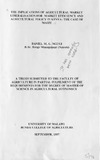| dc.description.abstract | Liberalisation of food and agricultural markets has been a major component of the Strucmral Adjustment Programs (SAP) in many African countries. In Kenya, liberalisation of the maize market, a process that was completed about three years ago, was one of the conditionalities for SAP funding. The motive for liberalisation is to promote market efficiency. But there is no sufficient quantitative evidence as to whether this goal has been realised or not. There is need for research not only to assess this program, but also to provide information for future policy formulation.
This study was carried out to examine the implications of market liberalisations for market efficiency and agricultural policy in Kenya and to make reccommendations for the future. The study looked specifically at liberalisation of the maize market in Kenya. Market integration was used as an indicator of market efficiency. The study employed correlation and cointegration analysis to determine market integration. An Error Correction Model was used to test for causality among markets and examine the occurence of central markets. However, markets are complex institutions, affected by many factors besides market integration. The study therefore also employed regression analysis to determine structural factors that affect market integration.
X I 1
The main data used is on retail prices from 13 markets in Kenya. Data spans the period between 1992 and early 1996, thus covering both the pre and post full liberalisation period. Data on determinants of market integration covers a number of factors including distance between markets, transport and communication network, price stabilisation policy and social disturbances.
The main lesson that emerges from this study is that market liberalisation has increased the efficiency of maize markets in Kenya. Nevertheless liberalisation on its own can not guarantee continued and increased market efficiency. There are needs such as social tranquility, reliable transport networks and information systems that need to be addressed if these efficiency gains are to be maintained and furthered.
The main implications of the study include first that the private sector has responded positively to maize market liberalisation and is running the market towards greater market efficiency, contrary to past fears that it would be unable to do so with negative implications particulary for food security. Secondly efforts should always be made to curb social disturbances and improve transport and market information systems to enhance efficiency of food and agricultural markets in Kenya. | en_US |



